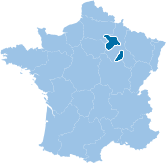The Champagne region is at the highest latitude of all the French wine regions. The grapes grown on its chalk soils — Pinot Noir, Pinot Meunier, and Chardonnay — produce a bone dry white wine, rather thin and largely undistinguished until transformed by a second fermentation in the bottle and some time on the lees produced in that second fermentation. In the early days, the first fermentation was interrupted before the yeasts consumed all the sugar: the doors to the cuverie were thrown open and the autumn chill stopped their work. The wine was then bottled and the remaining sugar fermented in the bottle, producing the bubbles that makes the wine famous. In modern production, the first fermentation proceeds to dryness (no sugar left), and the wine is dosed with yeast and sugar before bottling and the second fermentation there. Champagne acquires its complexity during its time in the bottle after the second fermentation completes. The dead yeast cells collect in the bottle and as the wine ages, they contribute complexity. After more than a year on the lees, the bottles are “disgorged:” tipped up gradually to move the lees into the neck. Then the wine and lees are frozen into a plug, the bottle is uncapped, and the plug flies out, after which the bottle is topped up and corked.
Our producer in Champagne is Pascal Bardoux, whose property is in the premier cru vineyards of Villedommange in the Montagne de Reims, part of a ring of premier cru vineyards immediately south of that city. His property is small — about ten acres — and planted half to Pinot Meunier and a quarter each Pinot Noir and Chardonnay. He makes both nonvintage and vintage Champagnes.


